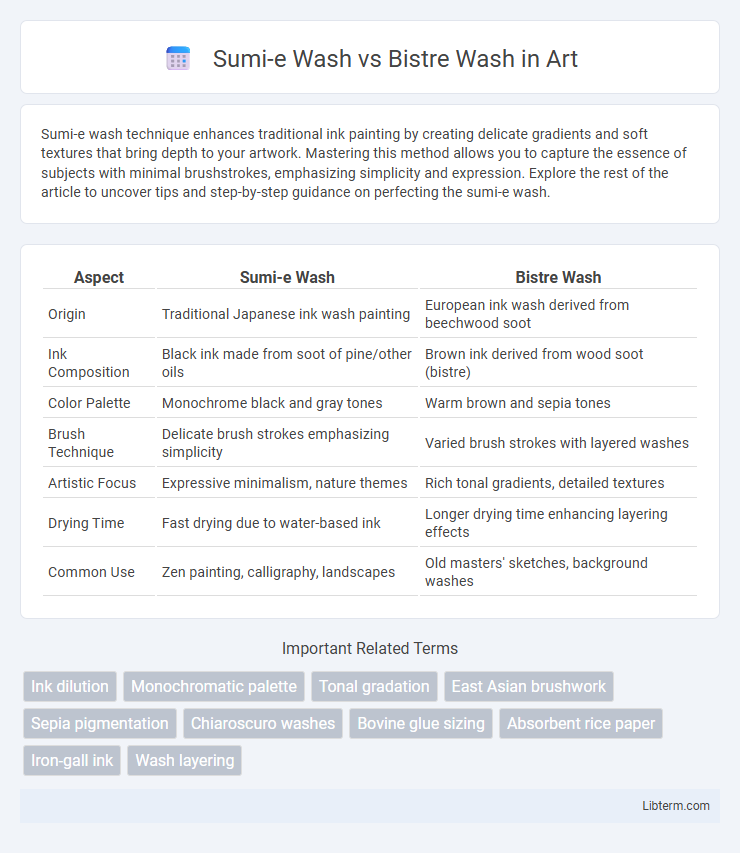Sumi-e wash technique enhances traditional ink painting by creating delicate gradients and soft textures that bring depth to your artwork. Mastering this method allows you to capture the essence of subjects with minimal brushstrokes, emphasizing simplicity and expression. Explore the rest of the article to uncover tips and step-by-step guidance on perfecting the sumi-e wash.
Table of Comparison
| Aspect | Sumi-e Wash | Bistre Wash |
|---|---|---|
| Origin | Traditional Japanese ink wash painting | European ink wash derived from beechwood soot |
| Ink Composition | Black ink made from soot of pine/other oils | Brown ink derived from wood soot (bistre) |
| Color Palette | Monochrome black and gray tones | Warm brown and sepia tones |
| Brush Technique | Delicate brush strokes emphasizing simplicity | Varied brush strokes with layered washes |
| Artistic Focus | Expressive minimalism, nature themes | Rich tonal gradients, detailed textures |
| Drying Time | Fast drying due to water-based ink | Longer drying time enhancing layering effects |
| Common Use | Zen painting, calligraphy, landscapes | Old masters' sketches, background washes |
Introduction to Sumi-e Wash and Bistre Wash
Sumi-e wash is a traditional East Asian ink wash technique using black ink derived from soot, creating soft gradients and expressive brush strokes in monochromatic palettes. Bistre wash involves a brown pigment extracted from wood soot, known for its warm sepia tones and subtle transparency ideal for tonal depth and antique effects in drawings. Both washes emphasize fluidity and layering but differ in cultural origins and color temperature, influencing artistic mood and style.
Historical Origins of Sumi-e and Bistre Techniques
Sumi-e wash, rooted in East Asian ink wash painting traditions from ancient China and Japan, uses black ink derived from soot and water to create expressive, monochromatic imagery emphasizing simplicity and brush fluidity. Bistre wash emerged in Europe during the 17th century, made from the sepia-toned pigment extracted from wood tar or beechwood soot, valued for its warm brown hues that enhanced depth in sketches and paintings. Both techniques reflect distinct cultural approaches to ink artistry, with Sumi-e focusing on spiritual minimalism and Bistre on tonal variation in Western art.
Essential Materials and Tools Comparison
Sumi-e Wash primarily utilizes black ink made from soot and animal glue, applied with soft, tapered brushes crafted from bamboo and animal hair to achieve fluid, expressive strokes. In contrast, Bistre Wash employs a brown pigment derived from wood tar, requiring brushes often made with stiffer bristles for textured effects and watercolor paper that enhances the pigment's granulation. Essential tools for Sumi-e emphasize precision and control, while Bistre Wash materials focus on creating warm tonal variations through layering techniques.
Techniques: Brushwork in Sumi-e vs Bistre Wash
Sumi-e brushwork emphasizes controlled, fluid strokes achieved through varying ink density and brush pressure, creating expressive simplicity and depth. Bistre wash technique involves layering diluted brown pigment with broad, sweeping washes to build tonal variation and texture. Both methods rely on brush manipulation, but Sumi-e focuses on precision and spontaneity, while Bistre wash highlights gradual tonal transitions and atmospheric effects.
Color Palette: Monochrome Ink vs Bistre Tones
Sumi-e wash utilizes a monochrome ink palette traditionally composed of varying shades of black and gray, emphasizing simplicity and subtle gradations to capture the essence of subjects. Bistre wash features warm brown tones derived from bistre ink, offering rich earthy hues that create depth and naturalistic effects in artwork. The color palette distinction influences the overall mood and texture, with sumi-e evoking minimalism and elegance, while bistre wash brings warmth and organic character.
Artistic Philosophies Behind Each Method
Sumi-e Wash emphasizes simplicity, spontaneity, and the beauty of imperfection, reflecting Zen Buddhist principles where each brushstroke embodies the artist's spirit and mindfulness. Bistre Wash focuses on capturing subtle tonal variations and atmospheric effects through layered washes, rooted in classical European techniques that prioritize realism and depth. The contrast between Sumi-e's minimalistic abstraction and Bistre's detailed gradation highlights divergent artistic philosophies centered on expression versus representation.
Popular Subjects and Themes
Sumi-e wash commonly features natural subjects such as bamboo, cherry blossoms, landscapes, and birds, emphasizing simplicity and the essence of the depicted scene. Bistre wash often explores historical themes, architectural elements, and sepia-toned portraits, highlighting detailed textures and tonal variation. Both techniques reflect cultural aesthetics but differ in their thematic focus: Sumi-e prioritizes spiritual symbolism while Bistre emphasizes realistic representation.
Visual Texture and Layering Differences
Sumi-e wash produces a soft, translucent visual texture with smooth gradients that emphasize simplicity and fluidity, often achieved through controlled brush pressure and water dilution. Bistre wash, by contrast, creates a richer, more granular texture with pronounced layering effects resulting from its sepia-toned pigment and denser application. The layering in Sumi-e builds subtle tonal variations, while Bistre layering adds depth and warmth through cumulative, textured strokes.
Common Challenges and Tips for Beginners
Sumi-e wash and Bistre wash both challenge beginners with their fluid control and layering techniques, often resulting in unintended blotches or uneven tones. Mastering brush pressure and understanding ink dilution ratios are essential to achieve the desired gradients and texture in Sumi-e wash, while in Bistre wash, pre-testing pigment concentration helps prevent overly dark or muddy areas. Practicing controlled wrist movements and using quality rice or watercolor paper can significantly improve outcomes in both traditional ink washes.
Choosing Between Sumi-e and Bistre Wash
Choosing between Sumi-e and Bistre wash depends on the desired tonal effects and cultural context in ink wash painting. Sumi-e utilizes black ink derived from soot for rich, varied grayscale gradients emphasizing simplicity and Zen aesthetics, while Bistre wash uses brownish ink from wood soot imparting warm, earthy tones suited for detailed, atmospheric landscapes. Artists aiming for subtle tonal variation with a monochromatic palette often prefer Sumi-e, whereas those seeking texture and warmth may opt for Bistre wash.
Sumi-e Wash Infographic

 libterm.com
libterm.com